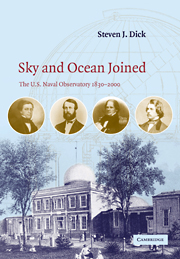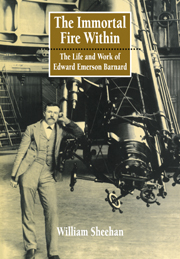Sky and Ocean Joined
As one of the oldest scientific institutions in the United States, the US Naval Observatory has a rich and colourful history. This volume is, first and foremost, a story of the relations between space, time and navigation, from the rise of the chronometer in the United States to the Global Positioning System of satellites, for which the Naval Observatory provides the time to a billionth of a second per day. It is a story of the history of technology, in the form of telescopes, lenses, detectors, calculators, clocks and computers over 170 years. It describes how one scientific institution under government and military patronage has contributed, through all the vagaries of history, to almost two centuries of unparalleled progress in astronomy. Sky and Ocean Joined will appeal to historians of science, technology, scientific institutions and American science, as well as astronomers, meteorologists and physicists.
- An authoritative history of one of the oldest scientific institutions in the United States
- Includes many colourful discoveries and adventures, such as the moons of Mars
- Ideal for academics and enthusiasts interested in naval history, positional astronomy and celestial mechanics
Reviews & endorsements
'… easy reading. It is well-illustrated and well-referenced … an historical tour-de-force, and I thoroughly recommend it to everyone interested in US astronomical history …' Journal of Astronomical History & Heritage
'There is no space to pull out more from Dick's fascinating and readable official history of the USNO, but I can thoroughly recommend it to anyone with an interest in time, navigation and their links to astronomy.' Astronomy
'… a fascinating and well written story …' The Naval War College Review
'… finely produced book rich in detail about an early exemplar of American institutional science, and one that complements studies of its other nineteenth- and twentieth-century counterparts very well'. BJHS Journal
'Dick has produced a text which is also extremely readable, with many relevant and interesting illustrations and a very thorough index. The entire production is of the highest standard, and both author and publisher are to be congratulated on the care which has gone into the design and content of the book. In the opinion of the reviewer this book is an outstanding example of the genre, quite the most important contribution to the literature of the history of astronomy to appear for many years.' The Antiquarian Astronomer
Product details
No date availablePaperback
9780521037501
624 pages
243 × 169 × 30 mm
0.986kg
223 b/w illus. 31 tables
Table of Contents
- Acknowledgements
- Abbreviations
- Introduction
- Prelude: perspectives and problems: the nation, the navy, the stars
- Part I. The Founding Era, 1830–65:
- 1. From depot to national observatory, 1830–46
- 2. A choice of roles: the Maury years, 1844–61
- 3. Foundations of the American Nautical Almanac Office, 1849–65
- 4. Gilliss and the Civil War years
- Part II. The Golden Era, 1866–93:
- 5. Scientific life and work
- 6. Asaph Hall, the great refractor and the moons of Mars
- 7. William Harkness and the transits of Venus of 1874 and 1882
- 8. Simon Newcomb and his work
- Part III. The Twentieth Century:
- 9. Observatory circle: a new site and administrative challenges for the twentieth century
- 10. Space: the astronomy of position and its uses
- 11. Time: a service for the world
- 12. Navigation: from stars to satellites
- Summary
- Select bibliographical essay
- Appendices
- Index.









